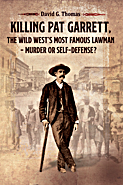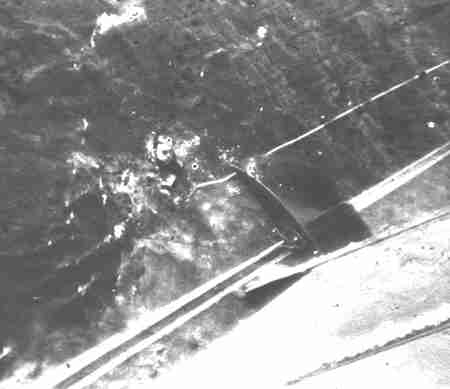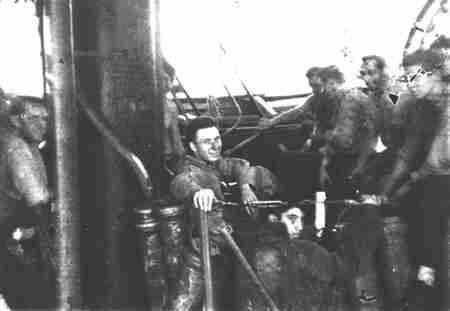|
|
||||||||||||||||||||||||
 |
||||||||||||||||||||||||
|
|
||||||||||||||||||||||||
|
||||||||||||||||||||||||
|
|
||||||||||||||||||||||||
 |
||||||||||||||||||||||||
 |
||||||||||||||||||||||||
 |
||||||||||||||||||||||||
|
|
||||||||||||||||||||||||
|
|
|
|
|
By Leonard A. "Len" Watson, VB-4 and VF-4 |
||||||
|
Essex Takes a Kamikaze - 25 November 1944 On November 25, after returning from a strike on a convoy off of Santa Cruz as a dive bomber pilot in VB-4, I asked the radio relay talker in the ready room to keep me informed if any bogeys were found coming in after us, as it was the Japs practice to follow returning planes to find the fleet. As I was getting out of my gear I heard him say, "Bogeys coming in." I decided to get some chow and to seek protection of the better armor plate above the wardroom, as I had seen prop blades go through the flight deck and into the ready room. Upon reaching the wardroom, I was disappointed to see cold cuts and stewed tomatoes as bill of fare—lousy meal for fighting men, I thought. Typical of the USS Essex. As I sat down at the table, there were about 10 pilots, mostly VT-4, sitting there. I lifted up the tablecloth after stating that bogeys were coming in. They asked what I was doing looking under the table. I said looking for the legs so I could get under in case we were bombed or hit! Everyone laughed. Then we were hit and dust and paint chips clouded the air. I went to get under and there was no room. I crawled on all fours to get to the reading room where I found a round table with a very scared mess boy cringing! I asked him where he was from, to calm him and myself down. Turned out to be from Detroit where I was from and near where I lived at the time of the outbreak of war. Shortly after, they started bringing wounded down and since I wasn't scheduled for another strike I elected to stay put. The tables and chairs were stacked in preparation for swabbing the deck so it presented an obstacle for the medics bringing in wounded. I saw several officers (Administration) standing around that had come in after the incident and I issued a very sharp command to clear an isle for the wounded. They jumped to the task and soon had it cleared and doctors and corpsmen set up the reading room for the needs of the wounded. All of the officers then looked around at the young pilot who had taken charge, not knowing my rank (as per orders we did not use our bars during combat). I sensed that they were aware the order was necessary and correct and none of us dwelled on it. I witnessed one young man on the table who asked the doctor if he was going to live. He assured him he would be all right. Yet, he shook his head to a corpsman who replaced him with another man. There was also a very large black person who had a bad burn on his upper arm, evidenced by the very pink flesh contrasting by the surrounding black skin, who insisted that they take care of others—that he would survive and could take the pain! Later I walked past the chow area—stewed tomatoes and cold cuts didn't fit the bill that day! I know you were there, as you described it in your book. This is my view. Dog Fight with Zekes - 15 December 1944 The following statement is from the official combat records: While recovering from this third attack northwestward from the ship, Lt(jg) Watson sighted two Zekes at 1500 feet northwest of Salvador Island on a southerly heading. The Zekes were flying in column and Lt(jg) Watson made a flat side approach on the leading Zeke and closed to a no deflection shot from astern. Hits were observed in the Zeke's fuselage, and its belly tank was ignited. As the Zeke nosed over, Lt(jg) Watson found that the second Zeke was on his tail. He immediately broke off the attack and turned away. In the meantime, Lt Tutwiler, who had followed Watson down in the attack on the ship, observed the encounter and made a high side run on the second Zeke which broke off its attack on Watson and turned into Lt Tutwiler's attack. The opposing aircraft fired on each other in this head-on encounter and Tutwiler could see his tracers entering the Zeke's engine. The Zeke pulled away and was last seen, losing altitude, toward a wooded area near the beach. I had been hit in the windshield and cowling, rendering my sight useless and forward vision impaired. Also, my guns were malfunctioning—only the outboard starboard gun was working. I was attempting to clear them by recharging and had my head in the cockpit when I looked up and saw the two Zekes. When the lead Zeke banked his wings and then flew straight ahead, I thought he was only showing he was friendly to what he observed to be a Zeke joining up or attacking. Anyway, I sprayed his plane with tracers/gunfire and set fire to his belly tank. My speed was too great and I had to chop my throttle to not overrun him and, at that moment, I noticed he was slumped forward and there were holes in his cockpit. At the same moment tracers came over my starboard wing and I threw all controls into the left corner just like I read Spitfires did to slice down through Germans in their Luftburg circle. It caused me to fall rapidly down like a side slip, but at a fast rate of speed. I did not see (W. J.) Tutwiler. (I wrote to him last week thanking him for getting Zeke off my tail!) Splash-Down - 16 December 1944 The official record states that the fighter sweep involving targets on Luzon lasted nearly 5 hours when: At 1700 Lt Watson was forced to make a water landing when his fuel supply was exhausted. He got clear of the plane but had difficulty in breaking out his life raft and abandoned it. Watson was supported by his life jacket while his pair leader circles the position until a DD, the USS Ingersoll, picked him up at 1710. First Day—December 16, 1944 After making a very good landing I had prepared everything quite correct—no problems and was getting ready to walk onto the wing and launch my rubber raft—so I thought! Then the water rushed in, engulfing me and forcing me back into my seat. I kicked at the instrument panel and both shins were scraped as my feet slipped off, but managed to get clear of the plane. Since I had already inflated my Mae West, I expected to pop to the surface, but looking up, it was not happening—I thought I was hung up with the plane. I pulled on the lanyard to my survival pack and found it was not fouled, but was holding me submerged. I tried to release it but could not disengage the snap. Momentarily, I envisioned myself drowning and gasped for air, gagging. I quickly told myself, "Stop, think—your only chance is to keep cool." I tried to get my hunting knife, so cleverly hidden in its sheath across my chest and shoulder, but the Mae West was too tight to retrieve the knife—back to the snap, pushed down—no release! Why? I looked down and dimly I could see it had a small button on it. Then I know the old type—must slide the button back to disengage—safety idea! Whose safety? But it worked, and I popped up to the surface just as Langley was making his last fly over to ascertain if I had survived the crash. I then had to see if the destroyer was indeed coming for me. At first I saw nothing, but when I turned to survey all the horizon, I first saw smoke and then as I bobbed up and down between the waves, I saw the ship (USS Ingersoll) a lot further then I expected coming in my direction. I thought to myself, "how small it looks" and wondered how they would spot me, a very, very small object in these wavy seas. Then I remembered my dye marker. I tried ripping the tab, but my fingers slipped off, so I bit the end of one pack and in the process of spitting out the stuff, caught a mouthful of seawater—ugly stuff, seawater and dye marker! Later, I would cause myself to vomit up per the advice from a corpsman! I'm glad I did, as the urinal was stained yellow! As the ship approached, I tried to swim towards it. The navigator, Lt Davis, using a blowhorn said "Don't try to swim, let us come to you." I complied and they did a great job. I was pulled along side with a rope, and grabbed the cargo net thrown down just touching the water—but I could not get my feet to the net and my arms were too weak to pull up, so two enlisted men reached down to help me. As soon as I could get my feet into the netting, I had no trouble getting aboard. It was then that Lt Davis said, "Oh, throw him back in—the game warden will get us, he's too small!" I would be assigned to his room while I was aboard this fine ship. |
||||||
 |
||||||
|
Leonard Watson being pulled toward the USS Ingersoll. |
||||||
|
Upon examining me on deck, someone said, "Be careful, he's hurt. Look as the blood on his pant legs." It turned out that bottles of iodine had broken in my leg pockets, staining them, and although I had skinned my shins on the instrument panel, there was no blood. Further examination in the sick bay showed no injuries, and after a shower and my skivvies and flight suit were washed and dried, I felt great after getting rid of the contents of my seawater and dye marker cocktail in the drink! |
||||||
 |
||||||
|
Leonard Watson aboard the USS Ingersoll after rescue. |
||||||
|
I was told to come to the wardroom for dinner and Skipper introduced me to the ship's officers and himself. I was also instructed in how to maneuver a soup dish, to eat soup aboard a rolling and pitching destroyer. The Skipper said that he would treat me to a steak if I didn't get sick while aboard his ship. He then told me that I would not be transferred back to the USS Essex that day! I got my steak the 19th, just before being transferred back to the USS Essex. I toured the ship and went to bed early—slept good—I liked the rocking motion of my rescue vessel. Second Day—December 17, 1944 Note: Lt(jg) Watson was not aware of the fact that Task Force 38.3 was now in the middle of a Pacific typhoon. Three destroyers, the Hull, Monaghan, and Spence, were sunk and 778 men died in this terrible storm. Virtually all the ships in the Task Force sustained damage. Watson's comments continue: Heavy sea—told too rough to refuel and would not be transferred that day! I took a walk out on the deck, talking to men who were glad to have a pilot on board and asked quite a few questions, mostly on landing, as they were often plane guard and so saw mucho accidents. I felt quite proud to have so much admiration expressed for us pilots. Then one of the group asked me if I wanted to go up in the crow's nest—GULP! I had fallen out of a tree when I was young and was snared by a large branch just before the sudden halt that would have injured me. Therefore, I was dubious of height, to say the least! But my reputation and that of all Navy pilots was on the line, so I climbed up the mast. Eeven though a good 20° arc and quite a wind whipped at the canvas, I did enjoy the view and had more respect for what the crew of destroyers had to endure, The BBs and CVs were all very stable platforms. The seas were growing rougher and the sky was overcast—I was glad I was on board and not bobbing up and down in the sea. Spent time in CIC and wardroom—ate sandwiches and retired. Third Day—December 18, 1944 Seas very rough—looking straight out into a high wall of water, could swear I saw a large fish. Crewman said 90 ft high—Admiral Halsey said 70 ft high off of battleship. I walked aft to see what it looked like through a passageway and stuck my head out to see right or left and was hauled back by a crewman, who said "You don't know when you can get washed away!" Just then spray drenched us both—I said "Got your point!" Went back to CIC and decided to stay put—listened to static on the radio and watched grass (static) return on the radar. Heard report: "Fire on hanger deck—Monterey dead in water—Man overboard!" No sooner had we all stated that the poor devil won't have a chance, when the radio crackled "We got him, we got him!" Seems he was lost at the bow and rescued aft, due to being dead in the water, the next wave put him in position to grab a life vest or ring! And I thought I had a problem! Then Admiral Halsey put out an order to all destroyers to man guns (small caliber) to shoot and sink aircraft that had washed off of cruisers. Scout planes were vulnerable to heavy typhoon seas. Our Skipper said, "Don't acknowledge that message!" I personally wasn't that fond of Halsey and his many attempts to come up with a famous wartime saying on our teletype in the ready room! They all have areas of immaturity, so I guess we can overlook these things! After a while, I became very sleepy as I usually do in low-pressure storm conditions and retired for the night, strapping myself in—and during my sleep we registered a 71° roll! When I awoke the desk top had come open and pens, paper, letters, etc. were all over the floor (deck) and the passageway had water and cardboard boxes floating by. I had slept like a baby through the very worst of the storm! The last day we saw debris floating by as we all were searching for survivors of three DEs that were sunk during the storm. I had my steak and was preparing to ride the breeches buoy over to the USS Essex. The swells were causing us to bob up and down, giving me a headache, and I began to taste my steak a second time, but I fought it off and was OK! As we pulled along the fantail of the USS Essex and got the lines set, the navigator, my roommate Lt Davis, announced, "We demand a ransom of ice cream be paid for return of Lt(jg) Watson!" The USS Essex's reply, "We don't have any!" Possibly the storm and GQ didn't allow any time to make it, or they were just being themselves. I felt terrible as I wanted to reward them in some way, so I took off my watch, my knife and sheath, my gun and holster, and started to take off my Mae West. The Skipper said, "You better not, you could still use that if we drop you in the drink on transfer." And would you believe it! I did have a scary moment when both ships swung together and both sides couldn't take up the slack quick enough, and I got my feet wet. On reaching my ship, a great roar and sigh of relief went up from both ships, as well as from one central figure involved. No one was there to welcome me back to the Air Group. No one had informed them I was coming back. I talked to Cdr K. G. Hammond the next day. No other person seemed to know I was gone. Having been transferred from VB-4 to VF-4, and only having been a fighter pilot for 16 days prior to the water landing, it was understandable. All the VB-4 squadron had transferred off the ship at Ulithi, to be replaced by Marine fighters. |
||||||
|
Air Group 4 - "Casablanca to Tokyo" |
|||
|
|
|||